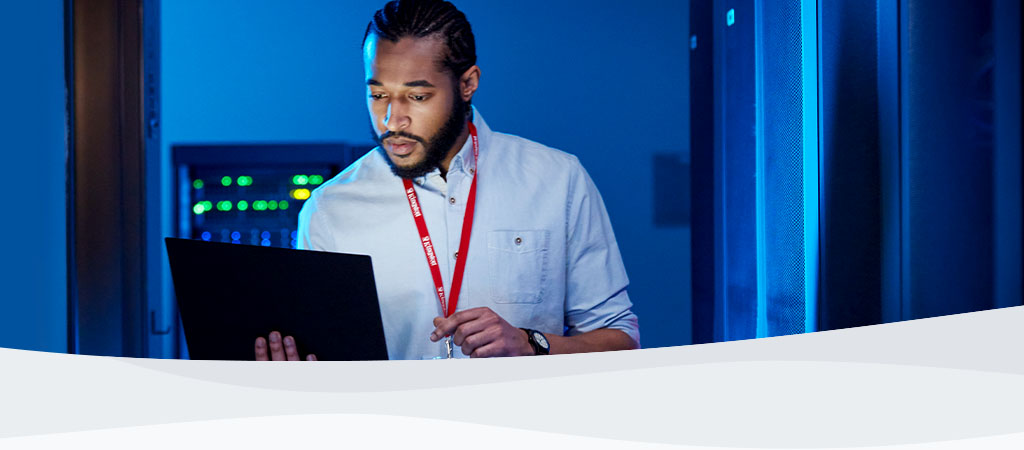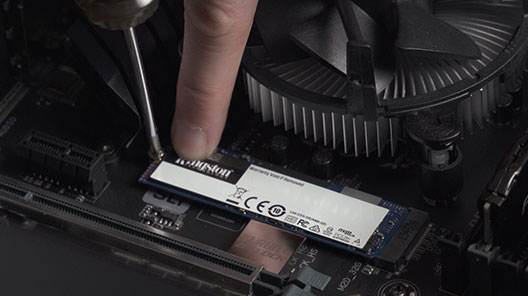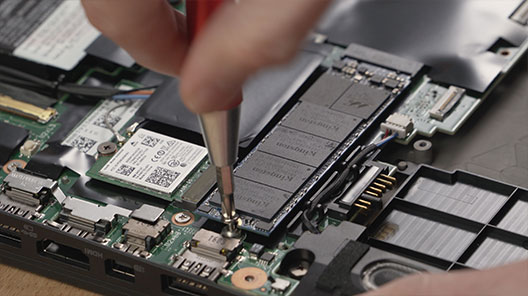
NV2 PCIe 4.0 NVMe SSD - Support
Resources
Videos
Frequently Asked Questions
2. Consult your system manufacturer’s support page to confirm if there is a BIOS update available for your system.
3. Confirm you’re running the latest version of your operating system and ensure that you don’t have any pending updates.
4. Confirm you are running the latest drivers for your system. You can do this by visiting your system manufacturer’s support page and looking for the latest driver updates.
If you’re still encountering issues with your system after these steps, please contact Kingston Technical Support.
FAQ: KSD-012010-001-21
Was this helpful?
This is common for flash storage, whether internal SSD or external USB storage. It is due in part to a variance in how flash memory vs spinning platter hard drive manufacturers calculate megabyte. Hard drive manufacturers calculate a megabyte (or 1,000x1,000 bytes) as 1,000KBs, whereas the binary calculation for flash-based storage is 1,024KBs.
Example: For a 1TB flash-based storage device, Windows will calculate it as having a capacity of 931.32GB. (1,000,000,000,000÷1,024÷1,024÷1,024=931.32GB).
Furthermore, Kingston reserves some of the listed capacity for formatting and other functions, such as firmware and/or controller-specific information, and thus some of the listed capacity is not available for data storage.
FAQ: KDT-010611-GEN-06
Was this helpful?
FAQ: KSD-001525-001-00
Was this helpful?
Please see our guide: Installing an M.2 SSDs
Also note, you may want to clone the drive you are replacing. See our guide on cloning your drive with the included Acronis software.
FAQ: KSD-012010-001-00
Was this helpful?
Please see our guides:
- Installing an M.2 SSD in a PlayStation® 5
- Upgrade Your PS5 Slim Internal Storage with a Kingston FURY SSD
FAQ: KSD-012010-001-01
Was this helpful?
If this is not possible, or if you previously cloned your old data to your new drive, confirm that the new drive appears as a boot device in the system BIOS, then select it for booting.
FAQ: KSD-012010-001-03
Was this helpful?
-Confirm that the system BIOS recognises your new SSD and if not, visit the motherboard / system manufacturer’s website to see if there is a new BIOS available.
-Verify your BIOS settings are configured to accept a new NVMe SSD.
-Confirm that your target operating system supports NVMe SSDs (e.g., Windows 8 or later)
Note: Kingston SSDs do not require additional drivers to operate.
FAQ: KSD-012010-001-05
Was this helpful?
Windows 7 doesn’t natively support NVMe SSDs. Please refer to Microsoft's hotfix explanation for installing Windows 7 on your NVMe SSD.
FAQ: KSD-012010-001-06
Was this helpful?
FAQ: KSD-012010-001-07
Was this helpful?
If the drive is present in the BIOS, you may need to initialise the disk within the operating system.
For Windows:
Step 1: Confirm the drive is properly attached, and power on the system, then boot into Windows OS.
Step 2: Press Windows + X and choose Disk Management.
Step 3: If the SSD is new and not initialised, a popup will appear saying "Initialize Disk".
Step 4: Choose between: MBR (Master Boot Record): Suitable for drives under 2TB and older systems. GPT (GUID Partition Table): Recommended for modern systems and drives larger than 2TB.
Step 5: Click OK to initialize the disk.
Step 6: Once initialised, you'll see the SSD as "Unallocated". Right-click on it and select New Simple Volume.
Step 7: Follow the on-screen prompts (keeping all defaults is Okay) to format and assign a drive letter to the SSD.
For macOS:
Step 1: Confirm the drive is properly attached, and power on the system, then boot into Mac OS.
Step 2: Open Disk Utility (you can find it using Spotlight with Cmd + Space and then typing "Disk Utility").
Step 3: In the left pane, select your SSD.
Step 4: Click on Erase.
Step 5: Provide a name for the drive, and under Format, choose: APFS for newer Macs and SSDs. Mac OS Extended (Journaled) for older systems or HDDs.
Step 6: Click Erase. Once the process completes, the SSD will be ready for use.
For Linux:
Step 1: Confirm the drive is properly attached, and power on the system, then boot into Linux OS.
Step 2: Open a terminal.
Step 3: Enter sudo fdisk -l to list all connected drives. Identify your SSD by its size and note the device name, e.g., /dev/sdb.
Step 4: Initialize the SSD using fdisk or parted. Here's a basic guide using fdisk: Enter sudo fdisk /dev/sdb (replace /dev/sdb with your SSD's device name). Press g to create a new GPT partition table. Press n to create a new partition. Follow the prompts to specify the size and type. Press w to write the changes.
Step 5: Format the new partition on the SSD (e.g., /dev/sdb1). You can format it with the filesystem of your choice: For ext4: sudo mkfs.ext4, For ext3: sudo mkfs.ext3 /dev/sdb1 /dev/sdb1, For FAT32: sudo mkfs.vfat /dev/sdb1
Step 6: Mount the SSD: Create a mount point: sudo mkdir /mnt/myssd, Mount the SSD: sudo mount /dev/sdb1 /mnt/myssd, Remember to replace /dev/sdb1 with your SSD's partition name.
FAQ: KSD-012010-001-15
Was this helpful?
There are a variety of external enclosures available on the market. While Kingston aims to be compatible with all system types, occasionally there may be an incompatibility.
If you’re having trouble with your non-Kingston SSD enclosure, please contact Kingston Technical Support for troubleshooting assistance.
FAQ: KSD-012010-001-18
Was this helpful?
No, Kingston does not offer an NVMe bundle upgrade kit.
FAQ: KSD-012010-001-30
Was this helpful?
SSD firmware is the integrated software within an SSD that manages its operations, including communication with the host system, data storage and retrieval, wear leveling, and error correction.
If your SSD requires new firmware, you will receive a notification when running Kingston’s SSD Manager software.
FAQ: KSD-012010-001-11
Was this helpful?
M.2 is the physical form factor. SATA and PCIe refer to the storage interface, the primary difference is performance and the protocol (language) spoken by the M.2 SSD.
The M.2 spec was designed to accommodate both a SATA and PCIe interface for SSDs. M.2 SATA SSDs will use the same controller currently on a typical 2.5” SATA SSDs. M.2 PCIe SSDs will use a controller specifically designed to support the PCIe protocol. An M.2 SSD can only support one protocol, but some systems have M.2 sockets that can support either SATA or PCIe.
FAQ: KSD-004005-001-00
Was this helpful?
Please see our guide regarding differences between these NVMe and SATA SSDs.
FAQ: KSD-012010-001-19
Was this helpful?
Please see our guide regarding the the differences between solid state drives and hard disk drives.
FAQ: KSD-012010-001-29
Was this helpful?
Kingston recommends updating your SSD to the latest available firmware, where possible. You can check to see if your drive has an available update by using Kingston’s SSD Manager software.
FAQ: KSD-012010-001-25
Was this helpful?
When cloning to a new drive larger than the source drive, the software may not properly scale partition size. When this occurs, you might end up with unused space. To avoid this please follow our cloning instructions.
FAQ: KSD-012010-001-04
Was this helpful?
SSD firmware is the integrated software within an SSD that manages its operations, including communication with the host system, data storage and retrieval, wear leveling, and error correction.
If your SSD requires new firmware, you will receive a notification when running Kingston’s SSD Manager software.
FAQ: KSD-012010-001-11
Was this helpful?
FAQ: KSD-012010-001-12
Was this helpful?
FAQ: KSD-012010-001-13
Was this helpful?
While it may be possible to update your target drive’s firmware via USB storage enclosure, Kingston recommends against this. Proper update procedure involves having your target SSD directly connected to the system ports (SATA or NVMe, where applicable).
FAQ: KSD-012010-001-14
Was this helpful?
When cloning to a new drive larger than the source drive, the software may not properly scale partition size. When this occurs, you might end up with unused space. To avoid this please follow our cloning instructions.
FAQ: KSD-012010-001-04
Was this helpful?
-Confirm that the system BIOS recognises your new SSD and if not, visit the motherboard / system manufacturer’s website to see if there is a new BIOS available.
-Verify your BIOS settings are configured to accept a new NVMe SSD.
-Confirm that your target operating system supports NVMe SSDs (e.g., Windows 8 or later)
Note: Kingston SSDs do not require additional drivers to operate.
FAQ: KSD-012010-001-05
Was this helpful?
If the drive is present in the BIOS, you may need to initialise the disk within the operating system.
For Windows:
Step 1: Confirm the drive is properly attached, and power on the system, then boot into Windows OS.
Step 2: Press Windows + X and choose Disk Management.
Step 3: If the SSD is new and not initialised, a popup will appear saying "Initialize Disk".
Step 4: Choose between: MBR (Master Boot Record): Suitable for drives under 2TB and older systems. GPT (GUID Partition Table): Recommended for modern systems and drives larger than 2TB.
Step 5: Click OK to initialize the disk.
Step 6: Once initialised, you'll see the SSD as "Unallocated". Right-click on it and select New Simple Volume.
Step 7: Follow the on-screen prompts (keeping all defaults is Okay) to format and assign a drive letter to the SSD.
For macOS:
Step 1: Confirm the drive is properly attached, and power on the system, then boot into Mac OS.
Step 2: Open Disk Utility (you can find it using Spotlight with Cmd + Space and then typing "Disk Utility").
Step 3: In the left pane, select your SSD.
Step 4: Click on Erase.
Step 5: Provide a name for the drive, and under Format, choose: APFS for newer Macs and SSDs. Mac OS Extended (Journaled) for older systems or HDDs.
Step 6: Click Erase. Once the process completes, the SSD will be ready for use.
For Linux:
Step 1: Confirm the drive is properly attached, and power on the system, then boot into Linux OS.
Step 2: Open a terminal.
Step 3: Enter sudo fdisk -l to list all connected drives. Identify your SSD by its size and note the device name, e.g., /dev/sdb.
Step 4: Initialize the SSD using fdisk or parted. Here's a basic guide using fdisk: Enter sudo fdisk /dev/sdb (replace /dev/sdb with your SSD's device name). Press g to create a new GPT partition table. Press n to create a new partition. Follow the prompts to specify the size and type. Press w to write the changes.
Step 5: Format the new partition on the SSD (e.g., /dev/sdb1). You can format it with the filesystem of your choice: For ext4: sudo mkfs.ext4, For ext3: sudo mkfs.ext3 /dev/sdb1 /dev/sdb1, For FAT32: sudo mkfs.vfat /dev/sdb1
Step 6: Mount the SSD: Create a mount point: sudo mkdir /mnt/myssd, Mount the SSD: sudo mount /dev/sdb1 /mnt/myssd, Remember to replace /dev/sdb1 with your SSD's partition name.
FAQ: KSD-012010-001-15
Was this helpful?
There are a variety of external enclosures available on the market. While Kingston aims to be compatible with all system types, occasionally there may be an incompatibility.
If you’re having trouble with your non-Kingston SSD enclosure, please contact Kingston Technical Support for troubleshooting assistance.
FAQ: KSD-012010-001-18
Was this helpful?
When cloning to a new drive larger than the source drive, the software may not properly scale partition size. When this occurs, you might end up with unused space. To avoid this please follow our cloning instructions.
FAQ: KSD-012010-001-04
Was this helpful?
Please see our guide: Installing an M.2 SSDs
Also note, you may want to clone the drive you are replacing. See our guide on cloning your drive with the included Acronis software.
FAQ: KSD-012010-001-00
Was this helpful?
Please see our guides:
- Installing an M.2 SSD in a PlayStation® 5
- Upgrade Your PS5 Slim Internal Storage with a Kingston FURY SSD
FAQ: KSD-012010-001-01
Was this helpful?
If this is not possible, or if you previously cloned your old data to your new drive, confirm that the new drive appears as a boot device in the system BIOS, then select it for booting.
FAQ: KSD-012010-001-03
Was this helpful?
-Confirm that the system BIOS recognises your new SSD and if not, visit the motherboard / system manufacturer’s website to see if there is a new BIOS available.
-Verify your BIOS settings are configured to accept a new NVMe SSD.
-Confirm that your target operating system supports NVMe SSDs (e.g., Windows 8 or later)
Note: Kingston SSDs do not require additional drivers to operate.
FAQ: KSD-012010-001-05
Was this helpful?
Windows 7 doesn’t natively support NVMe SSDs. Please refer to Microsoft's hotfix explanation for installing Windows 7 on your NVMe SSD.
FAQ: KSD-012010-001-06
Was this helpful?
There are a variety of external enclosures available on the market. While Kingston aims to be compatible with all system types, occasionally there may be an incompatibility.
If you’re having trouble with your non-Kingston SSD enclosure, please contact Kingston Technical Support for troubleshooting assistance.
FAQ: KSD-012010-001-18
Was this helpful?
If the drive is present in the BIOS, you may need to initialise the disk within the operating system.
For Windows:
Step 1: Confirm the drive is properly attached, and power on the system, then boot into Windows OS.
Step 2: Press Windows + X and choose Disk Management.
Step 3: If the SSD is new and not initialised, a popup will appear saying "Initialize Disk".
Step 4: Choose between: MBR (Master Boot Record): Suitable for drives under 2TB and older systems. GPT (GUID Partition Table): Recommended for modern systems and drives larger than 2TB.
Step 5: Click OK to initialize the disk.
Step 6: Once initialised, you'll see the SSD as "Unallocated". Right-click on it and select New Simple Volume.
Step 7: Follow the on-screen prompts (keeping all defaults is Okay) to format and assign a drive letter to the SSD.
For macOS:
Step 1: Confirm the drive is properly attached, and power on the system, then boot into Mac OS.
Step 2: Open Disk Utility (you can find it using Spotlight with Cmd + Space and then typing "Disk Utility").
Step 3: In the left pane, select your SSD.
Step 4: Click on Erase.
Step 5: Provide a name for the drive, and under Format, choose: APFS for newer Macs and SSDs. Mac OS Extended (Journaled) for older systems or HDDs.
Step 6: Click Erase. Once the process completes, the SSD will be ready for use.
For Linux:
Step 1: Confirm the drive is properly attached, and power on the system, then boot into Linux OS.
Step 2: Open a terminal.
Step 3: Enter sudo fdisk -l to list all connected drives. Identify your SSD by its size and note the device name, e.g., /dev/sdb.
Step 4: Initialize the SSD using fdisk or parted. Here's a basic guide using fdisk: Enter sudo fdisk /dev/sdb (replace /dev/sdb with your SSD's device name). Press g to create a new GPT partition table. Press n to create a new partition. Follow the prompts to specify the size and type. Press w to write the changes.
Step 5: Format the new partition on the SSD (e.g., /dev/sdb1). You can format it with the filesystem of your choice: For ext4: sudo mkfs.ext4, For ext3: sudo mkfs.ext3 /dev/sdb1 /dev/sdb1, For FAT32: sudo mkfs.vfat /dev/sdb1
Step 6: Mount the SSD: Create a mount point: sudo mkdir /mnt/myssd, Mount the SSD: sudo mount /dev/sdb1 /mnt/myssd, Remember to replace /dev/sdb1 with your SSD's partition name.
FAQ: KSD-012010-001-15
Was this helpful?
While it may be possible to update your target drive’s firmware via USB storage enclosure, Kingston recommends against this. Proper update procedure involves having your target SSD directly connected to the system ports (SATA or NVMe, where applicable).
FAQ: KSD-012010-001-14
Was this helpful?
FAQ: KSD-012010-001-13
Was this helpful?
FAQ: KSD-012010-001-12
Was this helpful?
SSD firmware is the integrated software within an SSD that manages its operations, including communication with the host system, data storage and retrieval, wear leveling, and error correction.
If your SSD requires new firmware, you will receive a notification when running Kingston’s SSD Manager software.
FAQ: KSD-012010-001-11
Was this helpful?
FAQ: KSD-012010-001-07
Was this helpful?

